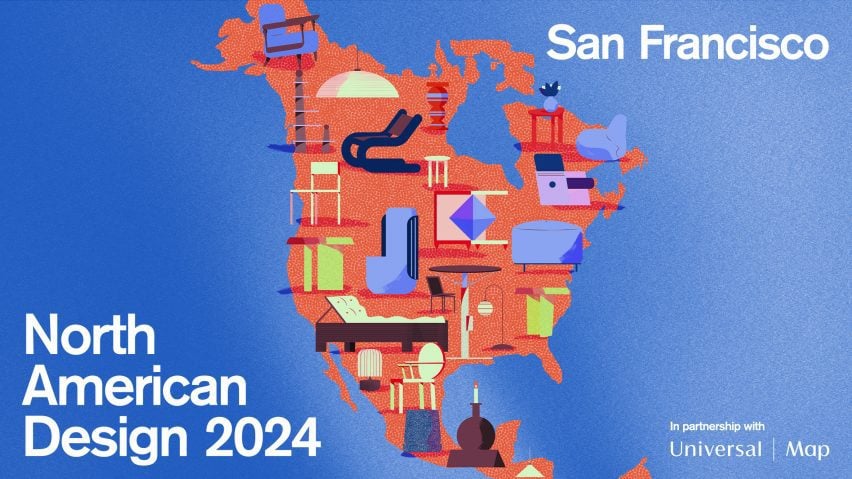
Ten independent design studios to watch in San Francisco
A boom box made with mycelium and a teeter-totter that reaches across the US-Mexico border are some of the projects from the 10 independent design studios from San Francisco presented as part of our North American Design 2024 series.
Experimentations in fabrication techniques and the use of high-tech methods can be found in the furniture and object design being carried out in San Francisco.
The northern Californian city is known as a hub of counter-culture and social activism as well as a central location for technological innovation, both of which can be found in the work of the 10 design studios below.
In San Francisco, design is often rooted in a desire to address pressing contemporary issues, including immigration, climate change and consumerism.
For architect Anand Sheth, who leads an eponymous studio and has lived and practised in San Francisco for 18 years, the city's design scene reflects the city's "inherently rebellious nature".
This rebelliousness is informed in part by the legacy of San Francisco as a counter-cultural hub, but also by the ways that contemporary designers respond to restrictive building and business codes, which cause severe delays to new construction and make operating a small business notoriously difficult.
"Rebelliousness is a theme that I see with my peers, and in my work too," said Sheth.
"It's not to say, 'let's just have anarchy'. No, it's a deeper investment in strategies to navigate a heavily restricted system and be in competition with other cities that don't have that type of pressure."
"My community has transitioned a lot – based on economic conditions of how people want to run their own businesses," he continued.
"A majority of my work is interiors, furniture and now art curation. And that's a natural response to recognizing that if I want to run the business the way I prefer to and stay nimble and independent, I don't really have a lot of opportunities to operate in the space of new construction or even major renovation."
Sheth explained that he sees the city's restrictions impact across disciplines and that many studios remain small in size not only because of city laws, but because of an "anti-capitalist" approach that allows for more considered production.
"Our culture is really not about speed, and so we get a chance to meditate and think deeply about how we behave and what we're putting into the world," he said.
Read on for 10 independent studios and designers that are part of shaping San Francisco's design culture today.
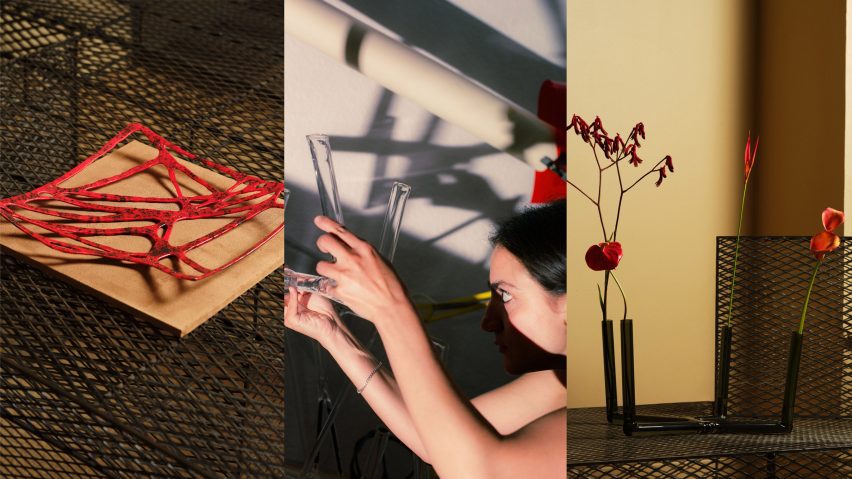
Sahra Jajarmikhayat
Designer Sahra Jajarmikhayat primarily uses glass, aluminium, wood, ceramic and biomaterials to create her research-driven work.
Jajarmikhayat's experimentations include extensive research and have ranged from objects created using 3D modelling based on volcanic data and mosquito nets made from lemons.
"I think about what happens to my pieces out in the world at their end of life before I start designing and that's why I have been gravitating towards glass, ceramics and metals due to their recycling capacities and biomaterials due to their degrading nature," she said.
"My goal as a designer is to work with cleaner and healthier materials – preferably upcycled and repurposed."
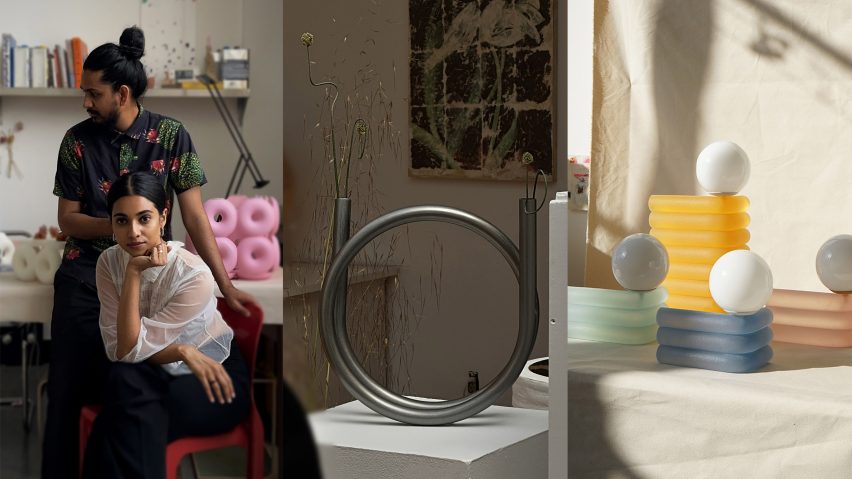
Soft Geometry
Designers Utharaa L Zacharias and Palaash Chaudhary first started collaborating during their undergraduate studies in New Delhi, continuing the partnership through their first jobs, grad school at SCAD and finally forming their studio Soft Geometry in 2019.
"With every piece that we design, we are looking at a different dimension of softness," said Zacharias. "As two people who arrived in the US in our twenties, navigating a huge change, finding our footing, and feeling stretched between two cultures, things often seemed harsh. We found softness in each other. We want our objects to be expressions of that feeling – of wanting and finding softness."
With no "dominant medium" at play, their work ranges from a chair wrapped in hand-woven yarn, and voice-controlled resin lamps, to a steel thali – a platter commonly used in India – that doubles as a mirror and speaks to their transient identities between the US and India.
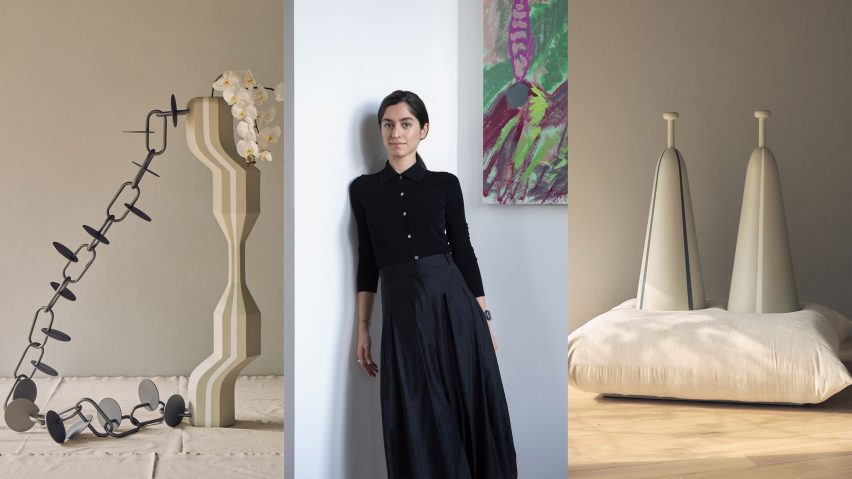
Saba Yazdjerdi
The work of designer and architect Saba Yazdjerdi is informed by her Iranian roots, as well as her experiences living in Bangkok and around the US, including Rhode Island for a graduate degree at Rhode Island School of Design.
"Since founding my studio in 2018, I've also developed a passion for designing sculptural objects that explore themes of identity and belonging, reflecting my architectural background and offering a tangible connection to my narratives," she said. "My approach to design centres on storytelling, addressing not only functional and aesthetic needs but also engaging in deeper cultural conversations."
Her most recent collection, the Pahlevoon Series, encompasses sculptural pieces and furniture informed by the objects used by ancient heroes and champions, or phalevani in Farsi, including the fibreglass and upholstery mil-gah bench, which features oversized versions of wooden clubs used for training atop a large cushion.
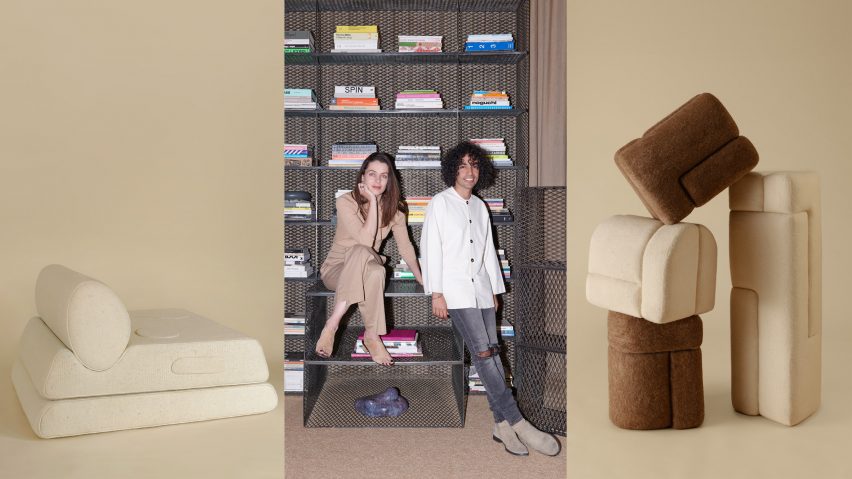
Studio Ahead
Designer Homan Rajai and artist Elena Dendiberia combine their Eastern and Western heritage in their work at Studio Ahead, which encompasses interior design, furniture design, styling and art direction.
"Studio Ahead's team charts out a new Silk Road, traversing their Eastern and Western sensibilities and their clients' cultural heritages," said the pair. "The studio's borderless approach to design creates evocative spaces where contrasts have room to grow."
A line of sheep wool furniture produced by the pair includes "soft sculptural forms" informed by the surrounding hills and rocks of Northern California as well as their shared experience of wool – Dendiberia having worn the material growing up in Russia and Rajai as the descendant of nomadic sheepherders from Iran.
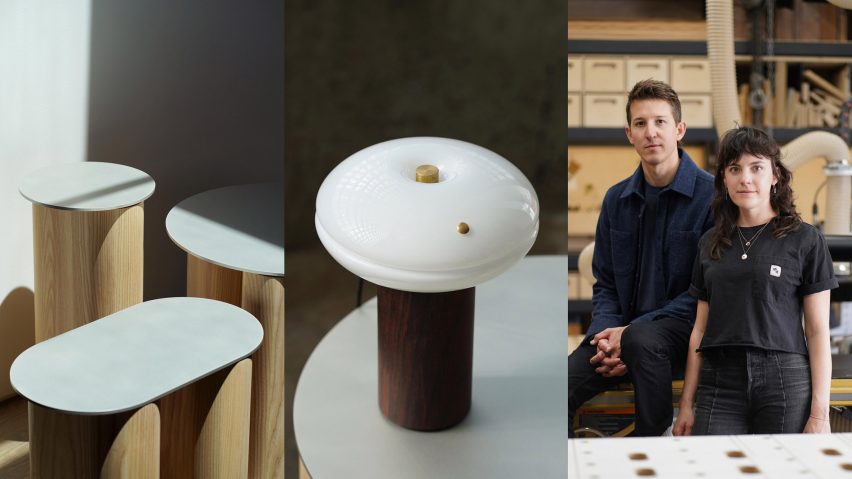
Medium Small
Brandt Hewitt and Megan McGuinn of Medium Small strive to "lift the lid" on the production process through their work, which features chairs, tables, lighting and other objects primarily made of hardwoods, metals, and glass.
Produced in collaboration with local fabricators, the designers use handcrafted techniques, industrial tooling, and CAD and CAM software to create their pieces.
"We love lifting the lid on a process, telling a story, and connecting people with how things are made," said the studio. "There is a lack of understanding, a disconnect between people and the products we use everyday, so we share process and inspiration through our practice."
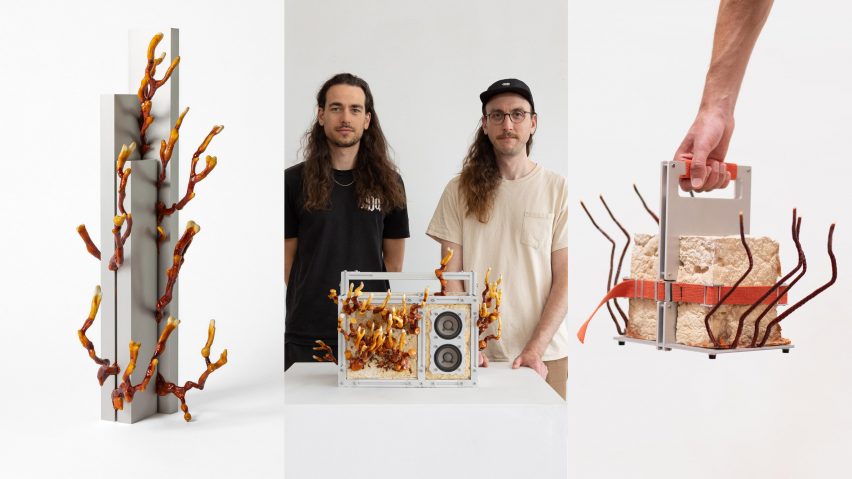
10th Floor Studio
"Fungi-inspired narratives" are at the centre of 10th Floor Studio, a multi-disciplinary practice led by Jerome Tavé and Kyle Lawson who aim to bring attention to environmental and social issues.
Many of the studio's objects, including a boom box, speaker and wearable objects, incorporate mycelium and mushrooms growing within an aluminium frame.
"In a time when climate action cannot be ignored, we hope to use our studio practice to contribute to the shift away from anthropocentrism," said the pair.
"Our pieces put forth a vision where brutalist, industrial logic is harmonized with warm organic chaos. The juxtaposition explores futures where humanity finds greater integration with other lifeforms, drawing attention to ecological and social issues, and inviting others into a realm of collaborative transformation."
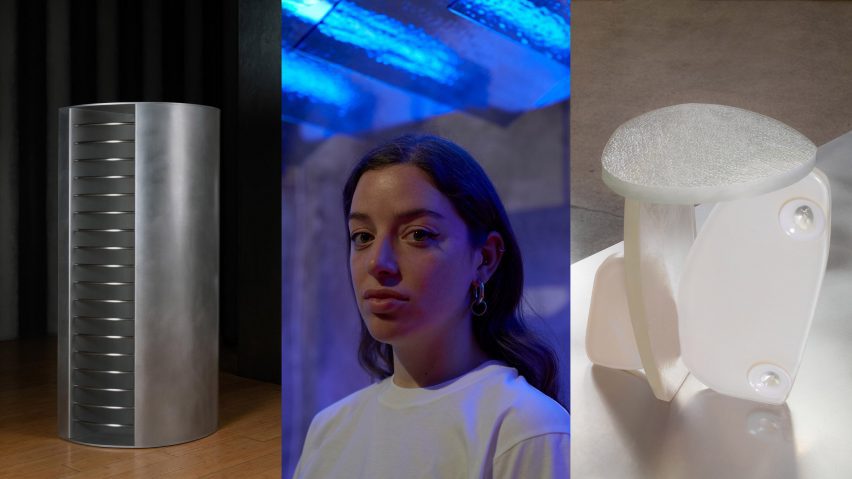
Kate Greenberg
Designer Kate Greenberg pursued architecture both in US and abroad before realizing she wanted to work with her hands, eventually attending school for furniture design and working at a concrete manufacturer.
Now, she produces furniture primarily made of aluminium, steel, glass, textiles and wood, which often features curved and amoeba-like forms.
"I suppose I am not satisfied with the rigid types of furniture we are offered in this world," she said. "It feels very capital market-driven, and not emotionally or psychologically driven. We'd be much happier if we had objects around that served us functionally, but also surprised us, gave color to daily rituals, and struck a chord with our inner identities."

Prowl Studio
"We are reorienting industrial design to achieve a regenerative future," said co-founders of industrial design practice Prowl Studio, Lauryn Menard and Baillie Mishler. "Instead of asking how we can do 'less bad', we ask how we can do 'the most good'."
The studio's work spans household lighting made for local company Gantri, to a stackable chair made largely of hemp as part of material research and fitting out the interior of the solar-powered Lightship RV.
"We start each project thinking about the inevitable end of a product's life while developing its design and use," they said. "This puts materials at the forefront of our process because, at the end of every product's relevant, useful, and functioning life, all that is left is its material composition."
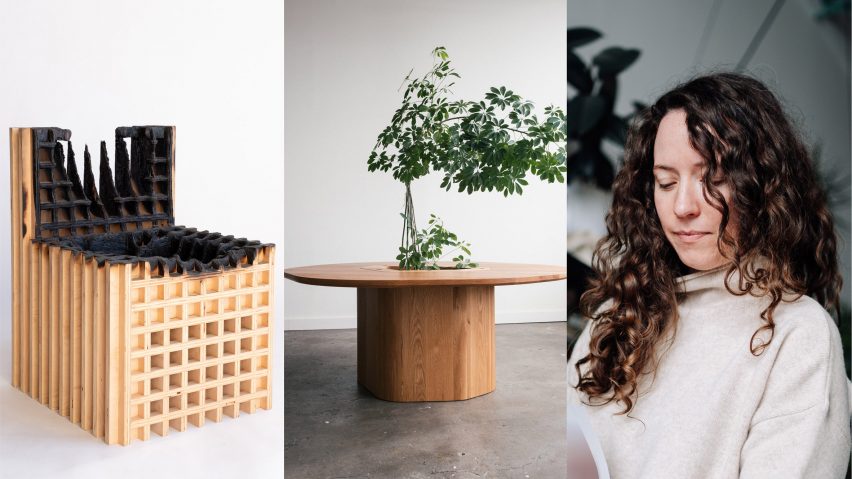
Yvonne Mouser
Designer Yvonne Mouser creates hand-crafted furniture, sculpture and everyday objects primarily with wood using "traditional methods" as well an ongoing pursuit of exploring new fabrication techniques.
Ranging from a charred, gridded chair to a honey dipper made in collaboration with designer Adam Reineck, Mouser describes her work as both "utilitarian" and an "implement for storytelling".
"I am particularly fascinated by our perception of natural phenomena and time, which I explore through work that suggests growth, decay, or sequences of temporal states to tease apart time," she said. "Each new effort is an exercise in restraint, focusing on the purity of an idea and the most direct construction methods in an attempt to achieve simplicity in the final outcome."
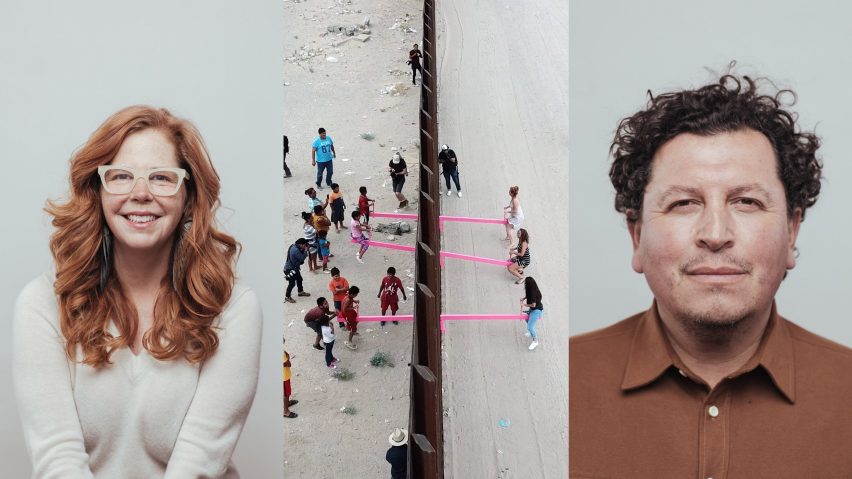
Rael San Fratello
Earth, snow, salt, sawdust, and coffee grounds are only some of the materials creative partners Ronald Rael and Virginia San Fratello of design studio Rael San Fratello use to create their work, which they describe as founded on the principles of "form, function, economy, beauty, and justice".
Among other projects, the studio is known for its "forty-minute guerilla event" Teeter Totter Wall, a series of pink teeter-totters that reached across the US-Mexico border and the 3D-printed raw earth structure Casa Covida, which they created through their 3D-printing studio Emerging Objects.
Through Emerging Objects and the recently founded Forust, the duo continues to explore 3D printing with a variety of materials at a building scale to produce housing and other objects that mitigate environmental impact and bring attention to social issues.
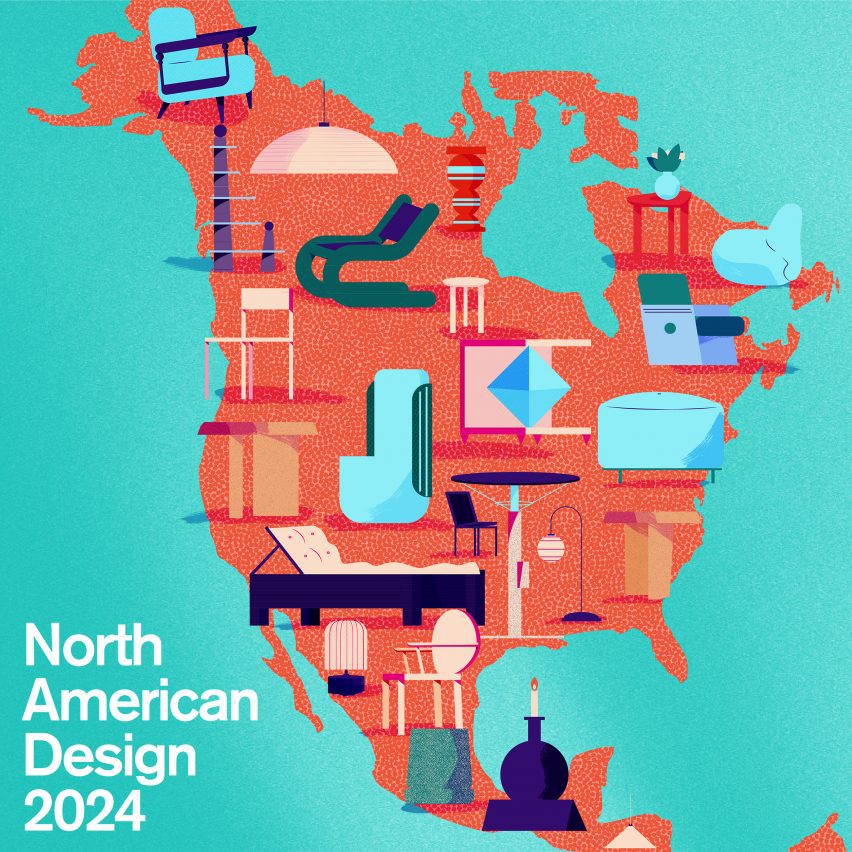
North American Design 2024
This article is part of Dezeen's North American Design 2024 series selecting independent furniture and product design studios from cities across Canada, Mexico and the United States.
The first edition of this series is created in partnership with Universal Design Studio and Map Project Office, award-winning design studios based in London and now in New York. Their expansion into the US is part of The New Standard, a collective formed with Made Thought.